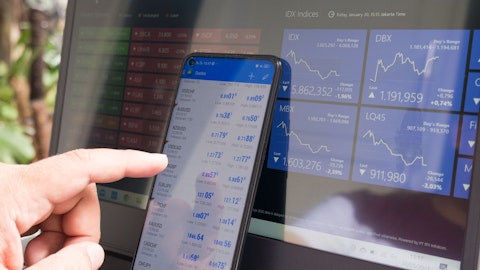In this article, we shall discuss 10 smartphones with the best antenna reception and call quality. To skip our detailed analysis of the global smartphone market in 2023, go directly and see 5 Smartphones with the Best Antenna Reception and Call Quality.
According to research by Counterpoint, the global smartphone market was valued at more than $205.1 billion in 2022, and is expected to reach $317.5 billion by 2028, at a CAGR of 7.55%. Global smartphone sell-through figures fell 8% year-on-year in Q3 2023, the ninth consecutive quarter to record a decline. However, volumes grew 2% quarter-on-quarter. The dip in sell-through volumes can be attributed to slower than expected recovery in consumer demand and a massive shift in device replacement patterns in developed markets. However, according to Counterpoint, the market’s QoQ growth points towards more favorable tailwinds in 2024, largely owing to the recovery of emerging markets, growth of brands outside the top five, and increased innovation in smartphones with the best antenna reception and call quality.
Samsung Electronics Co. (OTC:SSNLF) has continued its domination of the market, capturing more than 20% of global sales in Q3 2023. The company’s new generation of foldables outsold competition by nearly twice as much. Furthermore, Samsung’s (OTC:SSNLF) A-series models remained market leaders in mid-price brands, and rank amongst the smartphones with the best antenna reception and call quality. While the company is expected to concede its leadership in 6 countries, it is expected to surpass competition and secure the top position in other lucrative markets, like India and Malaysia. Apple Inc. (NASDAQ:AAPL) came at an incredibly close second to Samsung (OTC:SSNLF), capturing more than 16% market share in Q3 2023. This was despite the limited availability of iPhone 15 series, which has been garnering incredibly positive reviews thus far. As Samsung loses its grip over 6 key markets in the Philippines, Algeria, and Kuwait, Apple (NASDAQ:AAPL) is expected to swoop in and assume leadership in these key markets. The company’s expected rise to the top in major GCC markets is likely owing to the surging popularity of the iPhone 14 Pro series in the 4800 and above premium segment during the first half of 2023. As purchasing power in the GCC markets skyrockets and Samsung’s (OTC:SSNLF) sales succumb to TECNO’s and Vivo’s competitive pricing strategies, Apple Inc. (NASDAQ:AAPL) is set to dethrone Samsung (OTC:SSNLF) and assume dominance in key GCC markets. One of the most prominent success stories from 2023 has been Alphabet Inc. (NASDAQ:GOOG), whose Google Pixel series managed to capture more than 5% of market share, shipping nearly 1.3 million units of smartphones with the best antenna reception and call quality in Q3 2023. You can read more on the global smartphone market in our coverage of the 20 Most Valuable Smartphone Companies in the World.
Overcoming The Smartphone Challenge: An Analysis
According to a report by Bloomberg, global smartphone shipments are projected to record their worst annual performance in 2023 in more than a decade, owing to massive economic turbulence in China which is negatively impacting consumer spending. This, coupled with the fact that device-related expenses are straining margins considerably, is leading operators to face an uphill battle, especially in light of the 5G upgrade cycle. According to a report by McKinsey, smartphone companies like Samsung Electronics Co. (OTC:SSNLF), Apple Inc. (NASDAQ:AAPL), and Alphabet Inc. (NASDAQ:GOOG) simply cannot afford the financial stress of improving smartphone affordability for the average consumer. With sales dipping to around 1.3 billion new units per year due to high penetration levels, longer upgrade cycles, a transition away from flashy hardware innovation to less obvious software upgrades, and a relatively more established secondary market for used products, industry analysts expect 5G to reverse this trajectory and boost new phone sales growth for top-of-the-line OEMs by more than five percent. One primary challenge which awaits cellphone companies is the added cost associated with the 5G network buildout. As skyrocketing smartphone subsidy expenditure becomes more unsustainable, companies are looking to revisit their tactics to better constrain overall smartphone costs. To read more on the efforts smartphone companies are making to reduce costs, optimize sales, and develop smartphones with the best antenna reception and call quality, check out our coverage of the 10 Best Selling Smartphones in the World in 2023.
In this vein, these companies are looking to alter their approach with respect to smartphones and are trying to unlock value via end-to-end (E2E) device life-cycle management in order to manage key obstacles whilst maintaining innovation with conventional and unexplored levers like re-commerce, insurance, and subscriptions. If effectively executed, E2E device life-cycle management has the potential to garner substantial financial benefits in earnings before interest (EBITDA) and customer lifetime value (CLV). It can do this by significantly reducing costs, growing the top-line product portfolio through newer subscribers, encouraging higher levels of brand loyalty, and a greater popularity of additional services and accessories. Companies excel at identifying and dealing with selective, profitable areas of smartphone management. Procurement has become an increasingly significant concern when it comes to delivering consistently larger rebates from OEMs, and the finance department substantially builds on cash holdings through improved payment terms and receivables factoring.
Furthermore, it is becoming increasingly evident that optimizing the role of smartphones in the overall profit and loss (P&L) is not an utmost priority for any function. While companies tend to have dedicated project heads for more important functions like network or customer care, there is seldom a designated head for the smartphone vertical. Hence, McKinsey highlights that the first step to an effective E2E device life-cycle management approach is establishing a shadow smartphone P&L under the authority and supervision of a committed senior executive, which in turn, is a stark reflection of the different drivers of revenue and costs associated with some of the smartphones with the best antenna reception and call quality.
The Future of Smartphones: A Brief Overview
According to Forbes, the past couple of years have been defined by massive innovation within the global smartphone industry, ranging from top quality cameras and latest biometric identification capabilities to development of the best antenna reception and call quality. To have a deeper look into the future of innovation within the smartphone industry, Forbes conducted a survey with tech experts and discovered that top smartphone players like Samsung Electronics Co. (OTC:SSNLF), Apple Inc. (NASDAQ:AAPL), and Alphabet Inc. (NASDAQ:GOOG) are diverting increased investments in holographic displays, allowing consumers to interact with 3D holographic images, opening up new avenues for a better gaming experience, and an improved suitability for virtual and augmented reality. Companies are also looking to integrate universal wireless charging for entire product portfolios. With the growing popularity of the Qi standard, there is added functionality to wireless charging pucks and stands.
Furthermore, companies are also racing to implement improved AI and machine learning capabilities. Although smartphones are already able to perform a diverse variety of tasks using AI like language translation, image and voice recognition, and predictive text input. In addition to this, experts are also underscoring the growing importance to a longer-lasting battery life for the average consumer and better antenna reception and call quality. Apple Inc. (NASDAQ:AAPL) specifically has garnered extensive criticism for selling products with insufficient battery lives, leading to a massive PR hit for the company.

Our Methodology
To compile our list of 10 smartphones with the best antenna reception and call quality, we decided to undertake a consensus-based approach using a diverse variety of credible sources and research which studied animal cognition and intelligence (1, 2, 3, 4, 5, 6, 7). We picked phones which appeared at least twice in these sources, assigning them an average ranking based on the numbers at which they appeared on the lists. Low averages mean that the phone appeared at high ranks overall during our research. For instance, if a phone ranked number 1 in one list and number 2 on the other, the average ranking it obtained would be 1.5. Alternatively, if a phone ranked number 20 on one list and number 30 on another, the average ranking would be 25. We then arranged all the entries based on their average rankings, from highest to lowest.
Many of the phones which made our list also feature on our list of the 10 Best Smartphones with the Best Audio Quality.
Smartphones with the Best Antenna Reception and Call Quality
10. iPhone 15 Pro
Average Ranking: 17.5
The iPhone 15 Pro is widely perceived to have excellent antenna reception and call quality. Various users have reported that they tend to experience high-quality audio, even with a single signal bar. Other users report never losing signal in their respective cities. Some of its other features include a longer and more effective battery life, a larger screen, and impressive 5G network speeds. It is reported to have better signal reception than the iPhone’s previous generations.
9. Motorola One Vision
Average Ranking: 15
Being one of the best smartphones in terms of antenna reception and call quality, the Motorola One Vision was known to offer great value for money. Many of its users reported finding signals in secluded and isolated areas. The smartphone offered various other features to its users. Some of these features include a high-quality camera, an easy grip, and a positive battery life and performance.
8. Sony Xperia XZ3
Average Ranking: 14
Having one of the most exceptionally built screens in the world of smartphones, Sony Xperia XZ3 offered its users a high-end call quality and signal reception. This allowed the user to find reception, regardless of his or her location. The smartphone also offered incredibly advanced camera features and an easy-to-use interface for all users.
7. OnePlus 11 5G
Average Ranking: 12.5
The reviews of OnePlus 11 5G have been exceptionally positive in terms of Wi-Fi strength and cellular signals. The smartphone supports a respectable set of 5G bands, which allows the user to conveniently download files and speak on call. Other than that, OnePlus 11 5G offers various other features, including a vibrant display, strong processor performance, and fast charging.
6. OnePlus 10T
Average Ranking: 9.5
OnePlus 10T offers a total of 15 antennas to its users, which allows them to have strong Wi-Fi and cellular signals, regardless of the location or orientation of the device. The company, OnePlus, calls this feature a 360° Antenna System. Other than this, some of the main features of the smartphone include fast-charging, 120Hz bright and colorful AMOLED panel, and dependable performance. OnePlus 10T is number 6 on our list of smartphones with the best antenna reception and call quality.
Click here to continue reading and see 5 Smartphones with the Best Antenna Reception and Call Quality.
Suggested Articles:
- 12 High Growth IT Stocks to Buy
- 12 Best CBD Stocks To Buy Now
- 25 Best Online Law Degree Programs Heading Into 2024
Disclosure: None. 10 Smartphones with the Best Antenna Reception and Call Quality is originally published on Insider Monkey.





